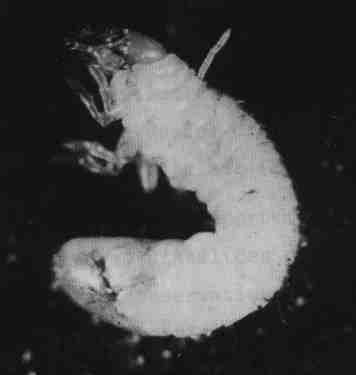|
HULL (1962): "The larvae of many genera live in soil. The larvae of the Laphriini and Andrenosomini usually live in decaying wood in old stumps, or beneth bark. I have seen no record of the larval habits of the Atomosiini. The larvae of the asilids have been frequently regarded as predatory in habit, especially by early writers. Perris (1871) found Laphria gilva Linné associated with Spondylis buprestoides and Criocephalus rusticus, both beetle larvae, and considered that they were preying on these beetles. Riley (1870) found Nerax femoratus Macquart larvae preying more than once on grasshopper eggs. Malloch (1917) states that all the larvae of the family that he has found are predatory, feeding on other insect larvae in spil as white grubs or in decaying wood. Melin discusses the evidence up to the time of 1923 with considerable detail. His own observations and experiments are quite to the contrary and he believes that the principal food of asilid larvae is vegetable in character. He presents what seems excellent evidence that asilid larvae subsist on a non-carnivorous-type of food. Melin believes that attack or consumption of animal food sources such as insect larvae in entirely secondary and sporadic, if indeed it ever actually takes place. While Malloch (1917) and Greene (1918) state that asilid larvae feed on other insect larvae, they do not claim to have verified this by direct, personal observation, that is, to have seen asilid larvae initiate the attack and extract the contents from larvae prey."
WOOD (1981): "Recent studies by several workers, however, have shown conclusively that the larvae are predators of the eggs, larvae, and pupae of other insects. Knutson (1972) has provided an excellent review of these studies. Of the three species that have been reared completely from egg to pupa, Promachus yesonicus Bigot was found to be a free-living predator of larval scarabaeids whereas the young larvae of Mallophora media Clements & Bennett and M. ruficauda (Wiedemann) are ectoparasites of larval Scarabaeidae. As the larva of M. media grows, it either becomes a free-living predator in the soil or continues to feed as an ectoparasite; M. ruficauda remains ectoparasitic on the host throughout development. Other workers have also observed ectoparasitism, at least by young larvae, but larvae of other Coleoptera, Hymenoptera, Diptera (including a record of cannibalism), and Orthoptera [eggs of Schistocera pregaria (Forskål)] have also been recorded as prey."

L2-larva of Machimus rusticus (Meigen, 1820) attached to a larva of Triodonta aquila Castelnau, 1840 [Musso 1978]
MUSSO (1983): "The observations and experiments carried out here made possible an accurate alimentary profile for larvae of several palaearctic species. It was also possible to distinguish differnet tropic behaviours during the preimaginal development of Machimus rusticus (Meigen 1820).
(a) The newly hatched larvae of this species (1000 larvae were studied take no food but only subsist on their yolk reserves. This behaviour has also been observed by 100 newly hatched larvae of Machimus pilipes (Meigen 1820).
(b) The second stage larvae of M. rusticus use the substances both excreted and exuded by Coleoptera larvae (Scarabaeidae), but also attach themselves temporarily to their cuticula. Since they cause the death of their host, these larvae can be considered as predators or more particularly as micropredators.
(c) From the beginning of the third stage and until the last larval stage, larvae of M. rusticus and other Asilinae and Dasypogoninae attack insect larvae and especially phytophagous insects and more particularly Coleoptera [Scarabaeidae, Curculionidae and Chrysomelidae]. They are actually predatory."
|